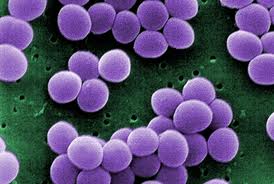 The previous literature specifically focusing on S aureus nosocomial pneumonia is limited. Our review of 60 patients is one of the largest reports of a real-world experience describing the outcomes of bacteremic staphylococcal pneumonia. The distribution of pathogens responsible for nosocomial pneumonia differs depending on factors such as the length of hospital admission before onset of the disease, admission to the ICU, and duration of mechanical ventilation. S aureus pneumonia typically develops in patients who have had a longer length of hospital stay before onset of disease, have received mechanical ventilation for > 5 days (ie, late-onset VAP), and have been exposed to previous antimicrobial therapy. A prediction model has been developed to determine which characteristics predict for the development of MRSA in patients with S aureus bacteremia. The greatest risk factor was previous antibiotic exposure with an odds ratio of 9.2 (95% confidence interval, 4.8 to 17.9). Rello and Diaz also found previous antimicrobial therapy to be a risk factor for MRSA pneumonia as well. Our findings for this cohort of 60 patients concur with this description. The median length of hospital stay before the first positive culture finding was 9 days. Most of our patients (93.3%) were in the ICU receiving mechanical ventilation (83.3%) at the onset of disease, and 55% of patients received antibiotic therapy prior to the onset of pneumonia. Furthermore, 71.4% of patients who developed MRSA pneumonia had received previous antibiotic therapy within 30 days prior to the onset of nosocomial pneumonia. This was significantly different from the 16.7% of MSSA pneumonia patients (p 80% of patients were already receiving mechanical ventilation at the onset of NBSAP, these percentages did not change after analyzing this subset of patients.
The previous literature specifically focusing on S aureus nosocomial pneumonia is limited. Our review of 60 patients is one of the largest reports of a real-world experience describing the outcomes of bacteremic staphylococcal pneumonia. The distribution of pathogens responsible for nosocomial pneumonia differs depending on factors such as the length of hospital admission before onset of the disease, admission to the ICU, and duration of mechanical ventilation. S aureus pneumonia typically develops in patients who have had a longer length of hospital stay before onset of disease, have received mechanical ventilation for > 5 days (ie, late-onset VAP), and have been exposed to previous antimicrobial therapy. A prediction model has been developed to determine which characteristics predict for the development of MRSA in patients with S aureus bacteremia. The greatest risk factor was previous antibiotic exposure with an odds ratio of 9.2 (95% confidence interval, 4.8 to 17.9). Rello and Diaz also found previous antimicrobial therapy to be a risk factor for MRSA pneumonia as well. Our findings for this cohort of 60 patients concur with this description. The median length of hospital stay before the first positive culture finding was 9 days. Most of our patients (93.3%) were in the ICU receiving mechanical ventilation (83.3%) at the onset of disease, and 55% of patients received antibiotic therapy prior to the onset of pneumonia. Furthermore, 71.4% of patients who developed MRSA pneumonia had received previous antibiotic therapy within 30 days prior to the onset of nosocomial pneumonia. This was significantly different from the 16.7% of MSSA pneumonia patients (p 80% of patients were already receiving mechanical ventilation at the onset of NBSAP, these percentages did not change after analyzing this subset of patients.
Patients included in this analysis were critically ill and had numerous underlying chronic comorbidities, as evidenced by a median APACHE II score of 20 (range, 3 to 41). Consequently, the mortality rate was high in our study, with an associated crude mortality rate of 55.5% and an IRM rate of 40.0%. These values also correlate well with those from previous literature in which the mortality rate attributable to S aureus has ranged between 28% and 50%. The mortality rate among nosocomial acquired bac-teremic pneumonia patients was found to be 52.5% in a previous study.
 The most surprising outcomes from our results were a lack of difference with respect to overall hospital mortality rate, IRM rate, and IR-LOS based on the receipt of early vs delayed antibiotic therapy. Numerous reports have been published stating that mortality significantly increases in patients who develop pneumonia if empiric antibiotic therapies are not started at the time of clinical suspicion, before cultures have been collected and sensitivity has been reported. Our lack of ability to detect a difference may be a product of a small sample size leading to a potential type II error. In a previous study examining S aureus bacteremia, a delay in therapy of > 44.75 h was found to be associated with a 3.8 times higher rate of IRM. The 44.75-h breakpoint for appropriate therapy, however, was not predictive in this series of pneumonia patients. In addition, an additional breakpoint of time to appropriate therapy was not identified using CART. Some potential reasons for no differences being detected are the low number of patients (n = 60) and the high mortality rate (55%) associated with this series. In addition, only 16 patients received appropriate antibiotic therapy within 24 h of the onset of infection. It may be difficult to ascertain the impact of delayed therapy given the high rate of delayed treatment.
The most surprising outcomes from our results were a lack of difference with respect to overall hospital mortality rate, IRM rate, and IR-LOS based on the receipt of early vs delayed antibiotic therapy. Numerous reports have been published stating that mortality significantly increases in patients who develop pneumonia if empiric antibiotic therapies are not started at the time of clinical suspicion, before cultures have been collected and sensitivity has been reported. Our lack of ability to detect a difference may be a product of a small sample size leading to a potential type II error. In a previous study examining S aureus bacteremia, a delay in therapy of > 44.75 h was found to be associated with a 3.8 times higher rate of IRM. The 44.75-h breakpoint for appropriate therapy, however, was not predictive in this series of pneumonia patients. In addition, an additional breakpoint of time to appropriate therapy was not identified using CART. Some potential reasons for no differences being detected are the low number of patients (n = 60) and the high mortality rate (55%) associated with this series. In addition, only 16 patients received appropriate antibiotic therapy within 24 h of the onset of infection. It may be difficult to ascertain the impact of delayed therapy given the high rate of delayed treatment.
Of interest, as demonstrated in Figure 1, a linear relationship existed with respect to IRM and increasing APACHE II score. Because of the requirement of concomitant bacteremia, this subset of pneumonia patients likely represents those patients who are most severely ill with rapid disease progression. The severe illness exhibited in these patients may be the main factor determining mortality and may serve as the reason why appropriate antibiotic treatment did not predict clinical success or decreased mortality. Another reason may be in part attributable to the slow activity or lack of efficacy of vancomycin, such that even the early administration of this agent is associated with poor clinical outcomes.
The greatest limitation of our study was the small number of patients (n = 60) who met our strict inclusion criteria. The main reason that so few patients were available for inclusion over the 5 years was the requirement for patients to have concomitant S aureus bacteremia, as well as pneumonia. This requirement was essential because of the retrospective design of our investigation and the high rate of tracheal aspirates used as the respiratory source of this pathogen. We wanted to be confident that the patients who were involved in this analysis developed bacteremia secondary to nosocomial pneumonia and not by hematogenous spread of S aureus, as can occur in other conditions, such as endocarditis, which was one of the exclusion criteria.
 Additional limitations were inherent to the retrospective design of the study. Characterizing NBSAP (https://www.cbd.int/nbsap) was difficult, although stringent inclusion criteria were used. Many patients who likely had nosocomial S aureus pneumonia were excluded from the analysis because of the lack of a concomitant positive blood culture finding. Also, numerous comorbidities confounded the accurate assessment of IRM. To account for this, an independent reviewer with no knowledge of the culture and sensitivity data or of the choice and timing of antibiotic therapy was designated to determine the primary outcome based on clinical data recorded throughout the course of the patient’s hospital stay.
Additional limitations were inherent to the retrospective design of the study. Characterizing NBSAP (https://www.cbd.int/nbsap) was difficult, although stringent inclusion criteria were used. Many patients who likely had nosocomial S aureus pneumonia were excluded from the analysis because of the lack of a concomitant positive blood culture finding. Also, numerous comorbidities confounded the accurate assessment of IRM. To account for this, an independent reviewer with no knowledge of the culture and sensitivity data or of the choice and timing of antibiotic therapy was designated to determine the primary outcome based on clinical data recorded throughout the course of the patient’s hospital stay.
In conclusion, this investigation includes one of the largest collections of patients to have bacteremic nosocomial pneumonia that was specifically attributable to S aureus. S aureus pneumonia developed late in the patient’s hospital stay and in ICU patients who had previously received mechanical ventilation, and was associated with a high crude mortality and IRM rates. No significant differences were detected with respect to crude mortality, IRM, or IR-LOS between patients who developed MSSA vs those who developed MRSA pneumonia or depending on whether the patient had received early vs delayed appropriate antibiotic therapy. The small sample size may have precluded our ability to detect a difference in these groups. Patients who were empirically treated with vancomycin for MSSA and MRSA pneumonia experienced a high mortality rate. These findings suggest that newer agents with enhanced clinical activity in NBSAP are needed and that these should be evaluated in a real-world setting, where outcomes of the sickest patients can be assessed. The group of patients who will experience the greatest benefit from these newer agents remains to be determined.
Want to know more about pneumonia? Read here:
Canadian Neighbor Pharmacy about Outcomes of Nosocomial Bacteremic Staphylococcus aureus Pneumonia
Epidemiology, Treatment, and Outcomes of Nosocomial Bacteremic Staphylococcus aureus Pneumonia
